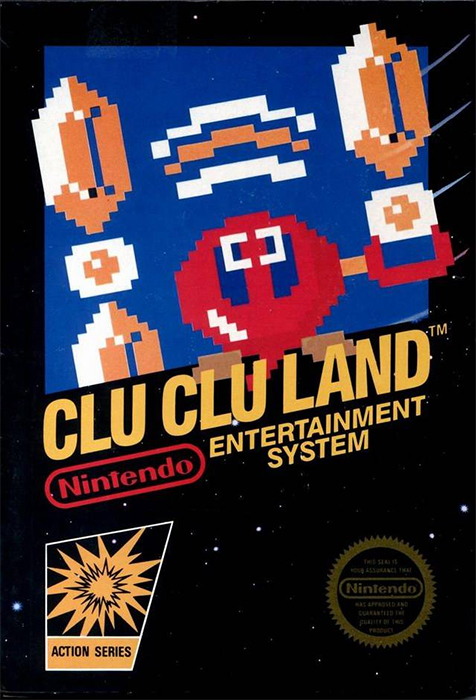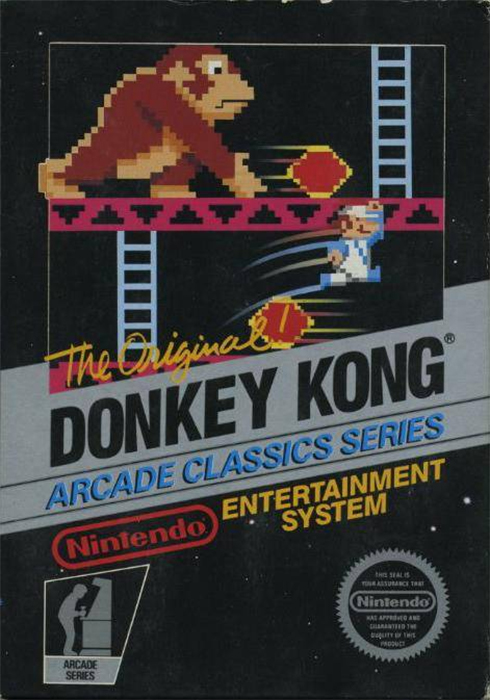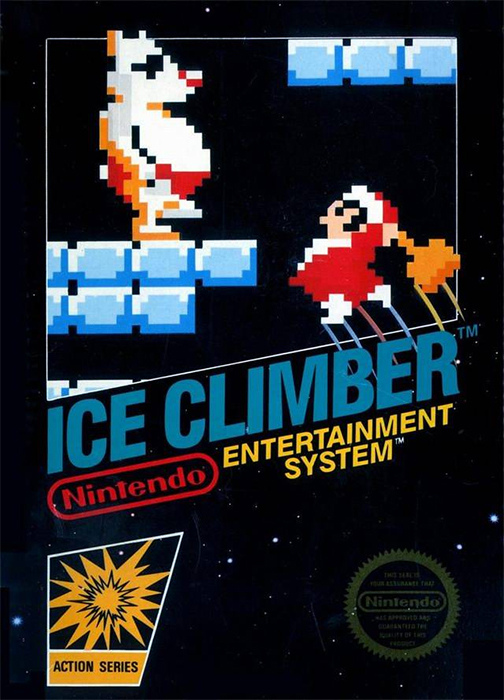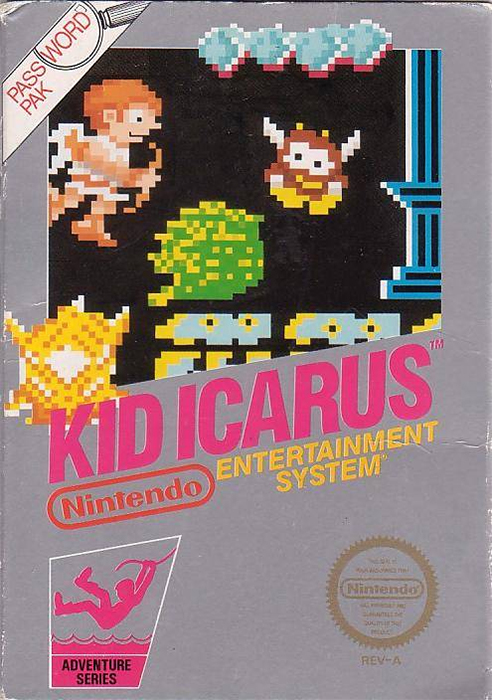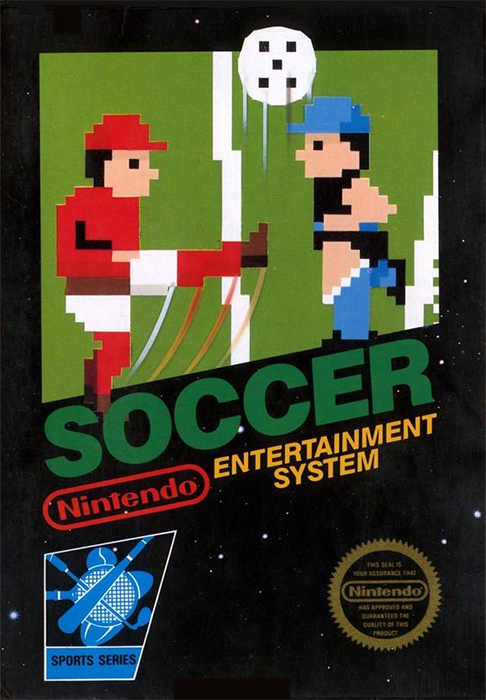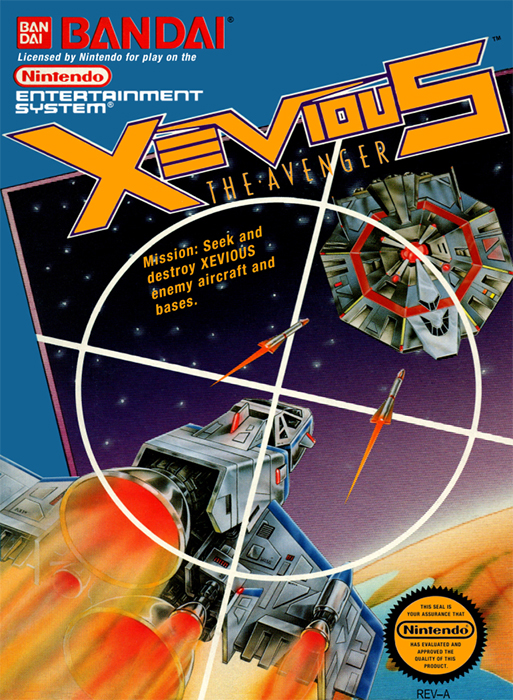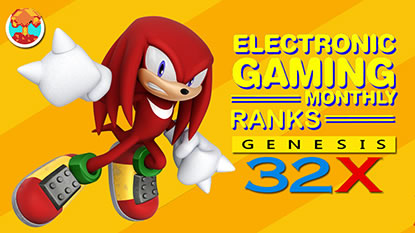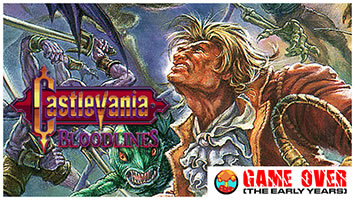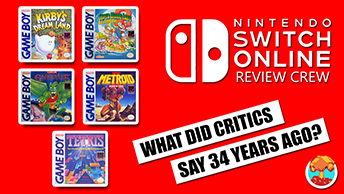- CLASSIC MAGAZINES
- REVIEW CREW
A show recapping what critics thought back
when classic games first came out! - NEXT GENERATION'S BEST & WORST
From the worst 1-star reviews to the best
5-stars can offer, this is Next Generation! - NINTENDO POWER (ARCHIVE)
Experience a variety of shows looking at the
often baffling history of Nintendo Power! - MAGAZINE RETROSPECTIVE
We're looking at the absolutely true history of
some of the most iconic game magazines ever! - SUPER PLAY'S TOP 600
The longest and most ambitious Super NES
countdown on the internet! - THEY SAID WHAT?
Debunking predictions and gossip found
in classic video game magazines! - NEXT GENERATION UNCOVERED
Cyril is back in this spin-off series, featuring the
cover critic review the art of Next Generation! - HARDCORE GAMER MAGAZING (PDF ISSUES)
Download all 36 issues of Hardcore Gamer
Magazine and relive the fun in PDF form!
- REVIEW CREW
- ELECTRONIC GAMING MONTHLY
- ELECTRONIC GAMING MONTHLY RANKS
From Mario to Sonic to Street Fighter, EGM
ranks classic game franchises and consoles! - ELECTRONIC GAMING MONTHLY BEST & WORST
Counting down EGM’s best and worst reviews
going year by year, from 1989 – 2009! - ELECTRONIC GAMING BEST & WORST AWARDS
11-part video series chronicling the ups and
downs of EGM’s Best & Worst Awards!
- ELECTRONIC GAMING MONTHLY RANKS
- GAME HISTORY
- GAME OVER: STORY BREAKDOWNS
Long-running series breaking down game
stories and analyzing their endings! - A BRIEF HISTORY OF GAMING w/ [NAME HERE]
Real history presented in a fun and pithy
format from a variety of game historians! - THE BLACK SHEEP
A series looking back at the black sheep
entries in popular game franchises! - INSTANT EXPERT
Everything you could possibly want to know
about a wide variety of gaming topics! - FREEZE FRAME
When something familiar happens in the games
industry, we're there to take a picture! - I'VE GOT YOUR NUMBER
Learn real video game history through a series
of number-themed episodes, starting at zero! - GREAT MOMENTS IN BAD ACTING
A joyous celebration of some of gaming's
absolute worst voice acting!
- GAME OVER: STORY BREAKDOWNS
- POPULAR SHOWS
- DG NEWS w/ LORNE RISELEY
Newsman Lorne Riseley hosts a regular
series looking at the hottest gaming news! - REVIEW REWIND
Cyril replays a game he reviewed 10+ years
ago to see if he got it right or wrong! - ON-RUNNING FEUDS
Defunct Games' longest-running show, with
editorials, observations and other fun oddities! - DEFUNCT GAMES QUIZ (ARCHIVE)
From online quizzes to game shows, we're
putting your video game knowledge to the test!- QUIZ: ONLINE PASS
Take a weekly quiz to see how well you know
the news and current gaming events! - QUIZ: KNOW THE GAME
One-on-one quiz show where contestants
find out if they actually know classic games! - QUIZ: THE LEADERBOARD
Can you guess the game based on the classic
review? Find out with The Leaderboard!
- QUIZ: ONLINE PASS
- DEFUNCT GAMES VS.
Cyril and the Defunct Games staff isn't afraid
to choose their favorite games and more! - CYRIL READS WORLDS OF POWER
Defunct Games recreates classic game
novelizations through the audio book format!
- DG NEWS w/ LORNE RISELEY
- COMEDY
- GAME EXPECTANCY
How long will your favorite hero live? We crunch
the numbers in this series about dying! - VIDEO GAME ADVICE
Famous game characters answer real personal
advice questions with a humorous slant! - FAKE GAMES: GUERILLA SCRAPBOOK
A long-running series about fake games and
the people who love them (covers included)! - WORST GAME EVER
A contest that attempts to create the worst
video game ever made, complete with covers! - LEVEL 1 STORIES
Literature based on the first stages of some
of your favorite classic video games! - THE COVER CRITIC
One of Defunct Games' earliest shows, Cover
Critic digs up some of the worst box art ever! - COMMERCIAL BREAK
Take a trip through some of the best and
worst video game advertisements of all time! - COMIC BOOK MODS
You've never seen comics like this before.
A curious mix of rewritten video game comics!
- GAME EXPECTANCY
- SERIES ARCHIVE
- NINTENDO SWITCH ONLINE ARCHIVE
A regularly-updated list of every Nintendo
Switch Online release, plus links to review! - PLAYSTATION PLUS CLASSIC ARCHIVE
A comprehensive list of every PlayStation
Plus classic release, including links! - RETRO-BIT PUBLISHING ARCHIVE
A regularly-updated list of every Retro-Bit
game released! - REVIEW MARATHONS w/ ADAM WALLACE
Join critic Adam Wallace as he takes us on a
classic review marathon with different themes!- DEFUNCT GAMES GOLF CLUB
Adam Wallace takes to the links to slice his way
through 72 classic golf game reviews! - 007 IN PIXELS
Adam Wallace takes on the world's greatest spy
as he reviews 15 weeks of James Bond games! - A SALUTE TO VAMPIRES
Adam Wallace is sinking his teeth into a series
covering Castlevania, BloodRayne and more! - CAPCOM'S CURSE
Adam Wallace is celebrating 13 days of Halloween
with a line-up of Capcom's scariest games! - THE FALL OF SUPERMAN
Adam Wallace is a man of steel for playing
some of the absolute worst Superman games! - THE 31 GAMES OF HALLOWEEN
Adam Wallace spends every day of October afraid
as he reviews some of the scariest games ever! - 12 WEEKS OF STAR TREK
Adam Wallace boldly goes where no critic has
gone before in this Star Trek marathon!
- DEFUNCT GAMES GOLF CLUB
- DAYS OF CHRISTMAS (ARCHIVE)
Annual holiday series with themed-episodes
that date all the way back to 2001!- 2015: 30 Ridiculous Retro Rumors
- 2014: 29 Magazines of Christmas
- 2013: 29 Questionable Power-Ups of Christmas
- 2012: 34 Theme Songs of Christmas
- 2011: 32 Game Endings of Christmas
- 2010: 31 Bonus Levels of Christmas
- 2009: 30 Genres of Christmas
- 2008: 29 Controls of Christmas
- 2007: 34 Cliches of Christmas
- 2006: 33 Consoles of Christmas
- 2005: 32 Articles of Christmas
- 2004: 31 Websites of Christmas
- 2003: 29 Issues of Christmas
- 2002: 28 Years of Christmas
- 2001: 33 Days of Christmas
- NINTENDO SWITCH ONLINE ARCHIVE
- REVIEW ARCHIVE
- FULL ARCHIVE
Nintendo Switch Online: 1990s Critics Review Donkey Kong, Kid Icarus, Rygar, Xevious, Soccer & More
Over the last nine months, we've been going back to the early days of the Nintendo Switch Online in order to give every game in the library the Review Crew treatment. As it stands today, there are only fifteen games left to be covered, all for the Nintendo Entertainment System. These include some of the system's earliest games, most of which were released in that review dead zone, when finding a review score was about as likely as capturing a picture of Bigfoot while riding a unicorn.
Of the fifteen games we still need to cover, nine of them were only reviewed by one magazine. That publication was Nintendo Magazine System, which was nice enough to offer up capsule reviews for many of these early games in their first issue. Instead of resorting to our usual format, I want to very quickly go through all nine of the remaining NES games reviewed by Nintendo Magazine System. This includes early classics like Donkey Kong, Ice Climber, Rygar, Kid Icarus and a whole lot more. I apologize in advance for the low-quality scans, but it's the best I could do for this special episode of Nintendo Switch Online Review Crew.
It's easy to write-off Clu Clu Land as nothing more than Nintendo's answer to Pac-Man, but this early Nintendo Entertainment System title is more than just a knock-off. Featuring a female balloon fish named Bubbles, this is a game all about revealing hidden ingots, which is basically the opposite of what you did in Pac-Man. There's more to it than that, of course, as Nintendo gave us an underwater world to survive and a unique mechanic that sees Bubbles grab onto a pole and swing around the playfield.
Like a lot of early NES titles, Clu Clu Land is extremely simple and repetitive. That said, it's a unique twist on the maze-game theme that was different enough from Pac-Man to warrant the attention. When they reviewed it, Nintendo Magazine System gave it a 62% and complained about the simplicity. “One of Nintendo's early efforts, Clu Clu Land is a sort of Pac-Man clone set in grids of dots. However, unlike Pac Man, the idea in Clu Clu Land is to direct your fish (?) between the dots, and thus reveal lines which made up a sort of Cubist join-the-dots picture. The simplistic gameplay is fun, but soon grows quite boring.”
When Nintendo released Donkey Kong in 1981, little did anybody know how important it would be to the company's future. This was not only the first game designed by legendary developer Shigeru Miyamoto, but it also introduced the world to both Donkey Kong and Mario (who was briefly known as Jumpman). These three names would be crucial to the success of Nintendo over the next fourty years, and this simple arcade game would cement the company as a real player in video gaming's early days.
Donkey Kong is also a truly great platformer that is still fun to pick up and play, though the critic at Nintendo Magazine System disagreed. When they reviewed the NES version, they gave it a 45% and said: “Oh no! Mario's girlfriend has been kidnapped by a crazed gorilla! It's up to the Italian plumber to conquer four different levels of platform action. Donkey Kong isn't a bad coin-op conversion, but the original itself is years old and four screens of arcade action simply isn't enough to warrant the price tag.”
Released just one year after the iconic first game, Donkey Kong Jr. flipped the tables by turning Mario into a villain and having us sympathize with the once-evil Donkey Kong. It's fun to go back and revisit these early Nintendo classics, as we see a company that knew they were onto something, but wasn't quite sure how to use their various characters. Just try to imagine a new game where Nintendo turned Mario into a bad guy, yet that's exactly what we get in Donkey Kong Jr. And it works. Although the story is simple, it makes sense and the platforming action is a lot of fun, offering new mechanics built around the young gorilla's abilities.
This is yet another great home conversion from Nintendo, though Nintendo Magazine System definitely had some complaints. Giving Donkey Kong Jr. a score of 46%, one tick up from the 45% they gave the original, the editors once again had some complaints about the length and simplicity. “Donkey Kong Junior's out to rescue his Dad from Mario's clutches in another four-screen platform romp, this time set in the jungle. Just like its predecessor, Donkey Kong Jnr isn't a bad conversion with a bit more variety than the original game. Unfortunately, four screens' worth of action just isn't enough to give the player value for money.”
Ice Climber isn't the sequel to the original Mario Bros., but it definitely feels like it. This is a game that takes the basic gameplay and physics of that single-screen Mario title and creates an entirely new experience where you (and a friend) are breaking through barriers and climbing a steep and dangerous mountain. Release not long before Super Mario Bros., Ice Climber is a game where Nintendo is clearly still working out a lot of their platforming ideas. With its sluggish control and weird jump mechanics, it's clear that the company still had some work to do. But even if it's not perfect, it's still fun to see Nintendo's stepping stones to success.
Of course, Nintendo Magazine System reviewed it after playing Super Mario Bros. and a whole bunch of other (better) Nintendo platformers. That helps to explain the 58% they gave the game: “Ice Climber is a pretty basic game, the object being to control your Eskimo to the top of each vertically scrolling level while keeping an eye out for enemy sprites. This was only of the first NES releases and has primitive graphics, sound and gameplay. Even the simultaneous two-player action doesn't stave off the tedium.”
Long before God of War, Nintendo was mining Greek mythology for an unlikely video game hero. Kid Icarus stands apart from a lot of the company's early titles, largely because of the way the levels were laid out and the mythological inspiration. This was also one of the first Nintendo Entertainment System games to come with a password save feature. It, along with Metroid and The Legend of Zelda, marked a new wave of larger and deeper NES games, a vast improvement over the more simplistic titles you saw in the early days.
Of course, none of that is what Nintendo Magazine System focused on when they reviewed the game. Giving it a not-so-great score of 68%, they concluded that “It's cutey platform game time as you guide Kid Icarus against an army of baddies who are just dying to clip his wings. It's pretty good fun, but the graphics are rather dated, and when you look at some of the more modern platform games around, this doesn't compare too well.”
Pro Wrestling wasn't the first wrestling game to hit the Nintendo Entertainment System, but it was definitely the first one worth playing. Featuring a colorful cast of fictional characters and just enough depth to keep the gameplay interesting, this is a game that got the wrestling elements right. It's also full of surprises, such as seeing the fight spill out of the ring. Best of all, it was an incredible two-player game that scratched that fighting game itch years before Capcom introduced us to The World Warriors.
You know who wasn't impressed with Pro Wrestling? That's right, it's Nintendo Magazine System, which gave the game a pitiful 45%. They concluded that “Pro Wrestling isn't quite as exciting as the real sport. The graphics are laughable with pathetic sprites and background visuals, and the sound isn't really any better either, sporting very weak spot effects. Our advice is to go for Tecmo World Wrestling. It's got better graphics, better sound and a huge amount of moves on offer.”
With his destructive shield-on-a-chain weapon and vibrant fantasy world, Rygar was a hit the moment it was introduced into arcades in the mid-1980s. Perhaps realizing that some of the fun and excitement would be lost with simplified graphics, Tecmo chose to create a new version of Rygar just for the Nintendo Entertainment System that added more depth to the gameplay and introduced new types of levels. That extra work paid off, as Rygar quickly became a go-to title on the NES, with many fans actually preferring this home release over the arcade original.
While gamers could spot the difference between the NES and coin-op versions of Rygar, I'm not sure the same can be said for Nintendo Magazine System. Giving it a solid 70%, they said that “the graphics in this beat ‘em up are okey-dokey and the gameplay is fairly interesting (thanks to the nice weapons), but on the whole, Rygar is probably only worth buying if you remember enjoying the coin-op.”
Having already dabbled in baseball, golf and tennis, it makes perfect sense that the next stop on Nintendo's sports tour was soccer. Much like the title suggests, this is a barebones 8-bit soccer game with simple graphics, basic gameplay and nothing even resembling a licensed team. Of course, you didn't really need all the bells and whistles, in the mid-1980s, because just having a good playing soccer game that does a reasonable job of simulating the sport was good enough for most people.
And that perfect describes Nintendo Magazine System, which was still impressed by this soccer game, despite the dated graphics, sound and control. Giving the game a shocking 83%, they said that “the action in this football game is a little slow, and the graphics are only adequate but it plays quite well and that's what counts. And even though it's positively ancient, it's still miles better than all the newer Nintendo football games.”
An arcade hit for both Atari and Namco, Xevious is an early ‘80s shoot ‘em up that incorporated both movement and vibrant colors, allowing it to stand-out from the competition. It's also a great playing game, too, as the game adds an extra layer of play to the action. Not only will players need to shoot down the enemies right in front of them, but you'll also need to bomb the ground below. As a home console port, I have to imagine that minds were blown when Xevious first hit the Famicom in 1984. Unfortunately, the game didn't come to America until 1988, which made it feel more like a relic from the past than a hotly-anticipated arcade port.
The game came out even later in Europe, which is probably why Nintendo Magazine System seemed lukewarm on the shooter. Giving it a score of 65%, they said: “The original coin-op's best feature was its pretty graphics, and these haven't been translated too well to the comparatively chunky-pixelled NES, so all you're left with is a passable, but hardly exciting up-the-screen blast.”
Of the fifteen games we still need to cover, nine of them were only reviewed by one magazine. That publication was Nintendo Magazine System, which was nice enough to offer up capsule reviews for many of these early games in their first issue. Instead of resorting to our usual format, I want to very quickly go through all nine of the remaining NES games reviewed by Nintendo Magazine System. This includes early classics like Donkey Kong, Ice Climber, Rygar, Kid Icarus and a whole lot more. I apologize in advance for the low-quality scans, but it's the best I could do for this special episode of Nintendo Switch Online Review Crew.
| Publication | Scores |
|---|---|
| Nintendo Magazine System | 62% |
| AVERAGE SCORE | 62% |
Like a lot of early NES titles, Clu Clu Land is extremely simple and repetitive. That said, it's a unique twist on the maze-game theme that was different enough from Pac-Man to warrant the attention. When they reviewed it, Nintendo Magazine System gave it a 62% and complained about the simplicity. “One of Nintendo's early efforts, Clu Clu Land is a sort of Pac-Man clone set in grids of dots. However, unlike Pac Man, the idea in Clu Clu Land is to direct your fish (?) between the dots, and thus reveal lines which made up a sort of Cubist join-the-dots picture. The simplistic gameplay is fun, but soon grows quite boring.”
| Publication | Scores |
|---|---|
| Nintendo Magazine System | 45% |
| AVERAGE SCORE | 45% |
Donkey Kong is also a truly great platformer that is still fun to pick up and play, though the critic at Nintendo Magazine System disagreed. When they reviewed the NES version, they gave it a 45% and said: “Oh no! Mario's girlfriend has been kidnapped by a crazed gorilla! It's up to the Italian plumber to conquer four different levels of platform action. Donkey Kong isn't a bad coin-op conversion, but the original itself is years old and four screens of arcade action simply isn't enough to warrant the price tag.”
| Publication | Scores |
|---|---|
| Nintendo Magazine System | 46% |
| AVERAGE SCORE | 46% |
This is yet another great home conversion from Nintendo, though Nintendo Magazine System definitely had some complaints. Giving Donkey Kong Jr. a score of 46%, one tick up from the 45% they gave the original, the editors once again had some complaints about the length and simplicity. “Donkey Kong Junior's out to rescue his Dad from Mario's clutches in another four-screen platform romp, this time set in the jungle. Just like its predecessor, Donkey Kong Jnr isn't a bad conversion with a bit more variety than the original game. Unfortunately, four screens' worth of action just isn't enough to give the player value for money.”
| Publication | Scores |
|---|---|
| Nintendo Magazine System | 58% |
| AVERAGE SCORE | 58% |
Of course, Nintendo Magazine System reviewed it after playing Super Mario Bros. and a whole bunch of other (better) Nintendo platformers. That helps to explain the 58% they gave the game: “Ice Climber is a pretty basic game, the object being to control your Eskimo to the top of each vertically scrolling level while keeping an eye out for enemy sprites. This was only of the first NES releases and has primitive graphics, sound and gameplay. Even the simultaneous two-player action doesn't stave off the tedium.”
| Publication | Scores |
|---|---|
| Nintendo Magazine System | 68% |
| AVERAGE SCORE | 68% |
Of course, none of that is what Nintendo Magazine System focused on when they reviewed the game. Giving it a not-so-great score of 68%, they concluded that “It's cutey platform game time as you guide Kid Icarus against an army of baddies who are just dying to clip his wings. It's pretty good fun, but the graphics are rather dated, and when you look at some of the more modern platform games around, this doesn't compare too well.”
| Publication | Scores |
|---|---|
| Nintendo Magazine System | 45% |
| AVERAGE SCORE | 45% |
You know who wasn't impressed with Pro Wrestling? That's right, it's Nintendo Magazine System, which gave the game a pitiful 45%. They concluded that “Pro Wrestling isn't quite as exciting as the real sport. The graphics are laughable with pathetic sprites and background visuals, and the sound isn't really any better either, sporting very weak spot effects. Our advice is to go for Tecmo World Wrestling. It's got better graphics, better sound and a huge amount of moves on offer.”
| Publication | Scores |
|---|---|
| Nintendo Magazine System | 70% |
| AVERAGE SCORE | 70% |
While gamers could spot the difference between the NES and coin-op versions of Rygar, I'm not sure the same can be said for Nintendo Magazine System. Giving it a solid 70%, they said that “the graphics in this beat ‘em up are okey-dokey and the gameplay is fairly interesting (thanks to the nice weapons), but on the whole, Rygar is probably only worth buying if you remember enjoying the coin-op.”
| Publication | Scores |
|---|---|
| Nintendo Magazine System | 45% |
| AVERAGE SCORE | 45% |
And that perfect describes Nintendo Magazine System, which was still impressed by this soccer game, despite the dated graphics, sound and control. Giving the game a shocking 83%, they said that “the action in this football game is a little slow, and the graphics are only adequate but it plays quite well and that's what counts. And even though it's positively ancient, it's still miles better than all the newer Nintendo football games.”
| Publication | Scores |
|---|---|
| Nintendo Magazine System | 46% |
| AVERAGE SCORE | 46% |
The game came out even later in Europe, which is probably why Nintendo Magazine System seemed lukewarm on the shooter. Giving it a score of 65%, they said: “The original coin-op's best feature was its pretty graphics, and these haven't been translated too well to the comparatively chunky-pixelled NES, so all you're left with is a passable, but hardly exciting up-the-screen blast.”
HOME |
CONTACT |
NOW HIRING |
WHAT IS DEFUNCT GAMES? |
NINTENDO SWITCH ONLINE |
RETRO-BIT PUBLISHING
Retro-Bit |
Switch Planet |
The Halcyon Show |
Same Name, Different Game |
Dragnix |
Press the Buttons
Game Zone Online | Hardcore Gamer | The Dreamcast Junkyard | Video Game Blogger
Dr Strife | Games For Lunch | Mondo Cool Cast | Boxed Pixels | Sega CD Universe | Gaming Trend
Game Zone Online | Hardcore Gamer | The Dreamcast Junkyard | Video Game Blogger
Dr Strife | Games For Lunch | Mondo Cool Cast | Boxed Pixels | Sega CD Universe | Gaming Trend
Copyright © 2001-2025 Defunct Games
All rights reserved. All trademarks are properties of their respective owners.
All rights reserved. All trademarks are properties of their respective owners.







